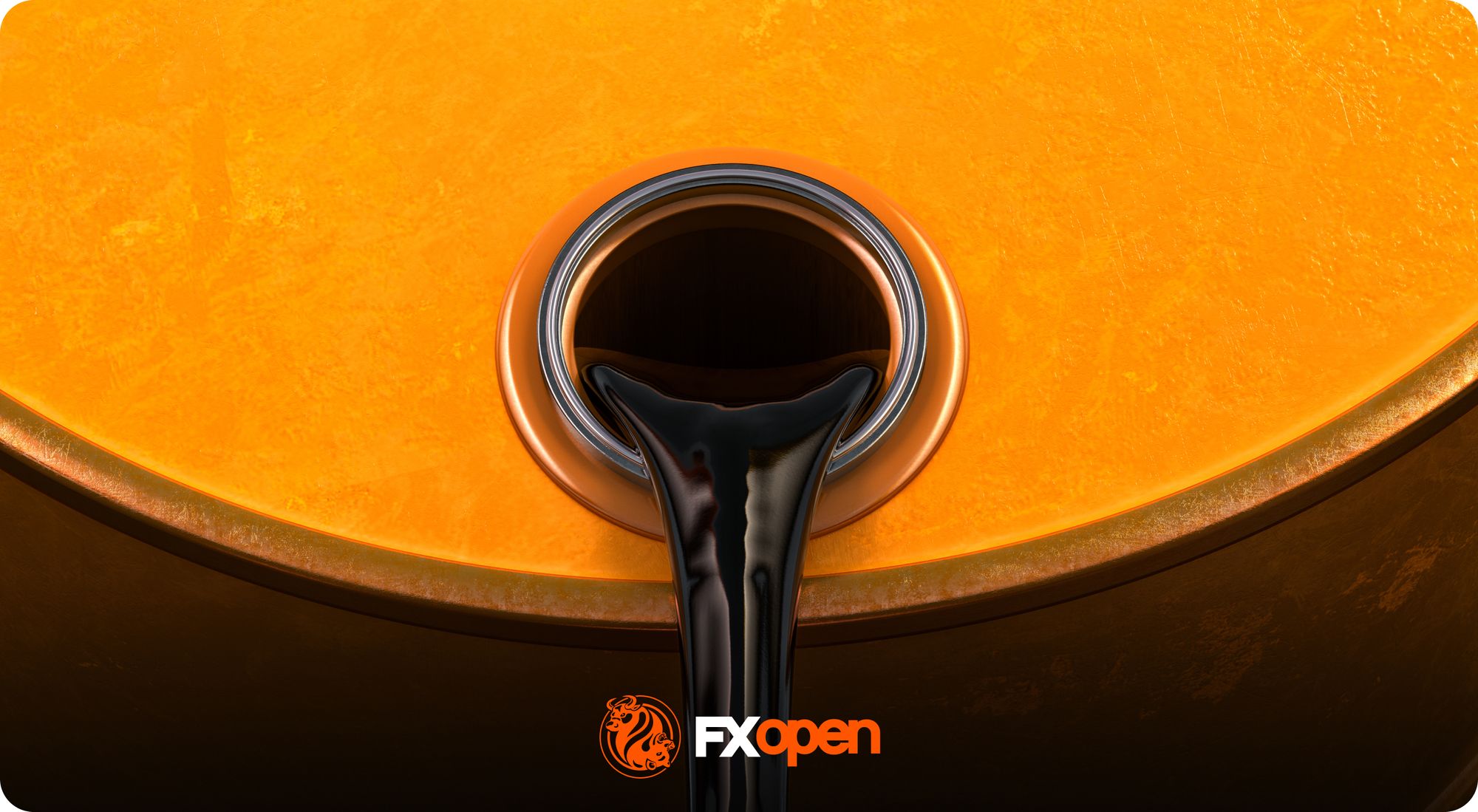FXOpen

Brent Crude and WTI are two of the most important oil benchmarks in the world, influencing global markets and trading strategies. While both represent high-quality crude, they differ in origin, composition, pricing, and market dynamics. This article explores questions like “What is Brent Crude?”, “What is WTI Crude?”, and “What is the difference between Brent and crude oil from West Texas?”, helping traders navigate their unique characteristics.
Brent Oil vs Crude Oil from West Texas
Brent Crude and West Texas Intermediate (WTI) are two primary benchmarks in the global oil market, each representing distinct qualities and origins.
What Is Brent Crude Oil?
Brent Crude originates from the North Sea, encompassing oil from fields between the United Kingdom and Norway, like Brent, Forties, Oseberg, Ekofisk, and Troll. This region's offshore production benefits from direct access to sea routes, facilitating efficient transportation to international markets. The North Sea's strategic location allows Brent Crude to serve as a global pricing benchmark and influence oil prices worldwide.
This blend is slightly heavier and contains more sulphur compared to WTI. Despite this, Brent Crude is extensively traded and serves as a pricing reference for about two-thirds of the world's oil contracts, primarily on the Intercontinental Exchange (ICE).
What Is WTI Crude Oil?
West Texas Intermediate is primarily sourced from US oil fields in Texas, North Dakota, and Louisiana. The landlocked nature of these production sites means that WTI relies heavily on an extensive network of pipelines and storage facilities for distribution. A key hub for WTI is Cushing, Oklahoma, which serves as a central point for oil storage and pricing. This infrastructure supports WTI's role as a benchmark for US oil prices.
Known for its lightness and low sulphur content, West Texas Crude is ideal for refining into gasoline and other high-demand products. WTI serves as a major benchmark for oil prices in the United States and is the underlying commodity for the New York Mercantile Exchange's (NYMEX) oil futures contract.
Brent and WTI Crude Oil CFDs
Most retail traders interact with Brent and WTI through Contracts for Difference (CFDs) instead of futures contracts. CFDs enable traders to speculate on price fluctuations without having to own the underlying physical oil. Instead, they open buy and sell positions and take advantage of the difference in the price from the time the contract is opened to when it’s closed.
This makes CFDs a popular choice for retail traders looking to make the most of short-term price fluctuations in oil without the complexities of physical ownership, storage, or delivery. CFDs also offer leverage, allowing traders to control larger positions with smaller capital.
You may consider trading Brent and WTI crude oil at FXOpen with tight spreads and low commissions! You can check the recent oil prices at the TickTrader trading platform.
Quality and Composition Differences
Brent Crude is classified as a light, sweet crude oil. It has an API gravity of approximately 38 degrees, indicating a relatively low density. Its sulphur content is about 0.37%, making it less sweet compared to WTI. Brent's composition is well-suited for refining into diesel fuel and gasoline, which are in high demand globally.
But what is WTI like? Known for its superior quality, WTI boasts an API gravity of around 39.6 degrees, making it lighter than Brent. Its sulphur content is approximately 0.24%, classifying it as a sweeter crude. This lower sulphur content simplifies the refining process, allowing for the production of higher yields of gasoline and other high-value products.
These differences in API gravity and sulphur content are significant for refiners. Lighter, sweeter crudes like WTI are generally more desirable because they require less processing to meet environmental standards and produce a higher proportion of valuable end products. However, the choice between Brent and WTI can also depend on regional availability, refinery configurations, and specific product demand.
Trading Volumes and Market Liquidity
Brent Crude and WTI both see significant trading volumes, but they differ in terms of their market liquidity and global reach.
As mentioned above, Brent Crude is widely traded on international markets, and it serves as the pricing benchmark for roughly two-thirds of the world's oil contracts. Its broad appeal comes from being a global benchmark, which makes it highly liquid in global exchanges like ICE Futures Europe.
This high liquidity means traders can buy and sell contracts with relative ease, often with tighter spreads. As a result, it’s popular among traders looking for high-volume, internationally-influenced oil exposure.
On the other hand, WTI is primarily traded in the US through exchanges like the NYMEX (New York Mercantile Exchange). While still highly liquid, WTI's trading volumes tend to be more concentrated within the US market.
Despite this, it remains a crucial benchmark, especially for traders focusing on the US oil industry. Its close ties to the domestic market mean liquidity can be slightly more affected by US-specific factors.
Pricing Influences and Differences Between Brent and WTI
The geographic focus and market influence distinguish WTI Crude vs Brent oil. Brent is a globally traded benchmark, making it more reactive to international forces, while WTI’s market is more US-centric, with pricing heavily influenced by domestic factors and energy dynamics.
Therefore, Brent Crude and WTI often trade at different prices, with Brent Crude typically priced higher. This price difference, known as the Brent-WTI spread, reflects the varying dynamics between global and US markets. Traders keep a close eye on this spread, as it signals the relative strength of international versus US oil markets.
Price Influences for Brent Crude
- Geopolitical events: Brent is highly sensitive to tensions or conflicts in major oil-producing regions like the Middle East and North Africa. Any disruptions to supply routes or production in these areas can cause its prices to spike.
- OPEC+ decisions: Since many OPEC+ members produce oil that influences Brent’s pricing, their decisions on production cuts or increases have a direct impact on its price. A reduction in global output typically raises prices.
- Global shipping and transport logistics: Brent is traded internationally, so shipping costs, potential blockages in transport routes (e.g., the Strait of Hormuz), and other logistics play a role in price movements.
- Global energy demand: Trends in global demand, especially from key regions like Europe and Asia, affect pricing. For instance, economic growth in these regions tends to push prices higher.
Price Influences for WTI
- US shale oil production: WTI is highly responsive to the levels of US shale oil output. When production surges, oversupply can put downward pressure on prices.
- US oil inventory levels: Key storage hubs like Cushing, Oklahoma, are crucial for pricing. Rising inventory levels signal oversupply, which typically lowers prices, while declining inventories may indicate higher demand and push prices up.
- Pipeline and transportation infrastructure: Bottlenecks in US oil pipelines or delays in transportation can influence WTI pricing. For instance, limited capacity in pipelines can restrict oil flow to refineries, leading to fluctuations in prices.
- Domestic energy policies: Government regulations, taxes, or subsidies affecting US energy production can impact prices, with changes in drilling activity or environmental policies influencing supply levels.
Which Oil Do Traders Choose?
When deciding between WTI vs Brent, traders consider their market focus, trading strategy, and the factors driving each benchmark. Here’s an overview of what might help you choose:
1. Geopolitical Focus
- Brent Crude is more sensitive to global geopolitical events, making it a strong choice for traders who focus on international markets. If you analyse global tensions, OPEC+ decisions, or international energy policies, Brent is likely more relevant.
- WTI is less influenced by global events and more driven by US domestic factors. Traders focused on US politics, infrastructure, and energy policies may find WTI a better fit.
2. Market Liquidity and Trading Volume
- Brent Crude is widely traded across global exchanges, giving it strong liquidity. It’s ideal for traders who prefer access to international markets and global trading volumes. Its liquidity also makes it attractive for those trading larger volumes or seeking tighter spreads.
- WTI has high liquidity as well, but it’s more concentrated in US markets. This makes it better suited for traders with a specific interest in US oil dynamics.
3. Price Volatility
- Brent Crude tends to react more to geopolitical shocks, meaning it can experience more volatility from global crises. Traders looking for opportunities driven by international supply disruptions or geopolitical risks might prefer Brent.
- WTI is typically influenced by domestic production and inventory levels, which can result in different volatility patterns. US-focused traders or those tracking domestic shale oil production often gravitate toward WTI for its more region-specific volatility.
4. Regional Focus
- Brent Crude is favoured by traders who have a global outlook or trade oil products tied to European, Asian, or African markets.
- WTI is a solid choice for traders interested in US oil markets or those who rely on data from domestic US reports like the EIA.
The Bottom Line
In summary, understanding the differences between Brent Crude and WTI is crucial for traders analysing global oil markets. Both benchmarks offer unique opportunities depending on your trading strategy and market focus, whether you prefer the global influence of Brent or the US-centric dynamics of WTI. To get started with Brent and WTI CFDs, consider opening an FXOpen account for access to these key markets alongside low-cost trading conditions.
FAQ
Why Is Oil Called Brent Crude?
Brent Crude gets its name from the Brent oil field located in the North Sea, discovered by Shell in the 1970s. The name "Brent" was derived from a naming convention based on birds—specifically, the Brent goose. Over time, it’s become the benchmark for oil produced in the North Sea, now serving as a global pricing standard for much of the world's oil supply.
What Does WTI Stand For?
WTI stands for West Texas Intermediate. It refers to a grade of crude oil that is primarily produced in the United States, specifically from oil fields in Texas, North Dakota, and surrounding regions. WTI is one of the key benchmarks for oil pricing, particularly in North America.
Is Brent Crude Sweet or Sour?
Brent Crude is considered a light, sweet crude oil. It has a low sulphur content, making it easier to refine into high-value products like gasoline and diesel. However, it contains slightly more sulphur than WTI, which is why it's marginally classified as less sweet.
Why Is Brent Always More Expensive Than WTI?
Brent is often more expensive than WTI due to its global demand and greater sensitivity to geopolitical risks. Brent is influenced by international factors, including OPEC+ decisions and conflicts in key oil-producing regions, which often lead to supply disruptions. WTI, meanwhile, is more affected by domestic US supply and demand.
Is Saudi Oil Brent or WTI?
Saudi oil is neither Brent nor WTI. It falls under its own classification, primarily as Arabian Light Crude. However, Brent Crude is often used as a pricing benchmark for oil exports from Saudi Arabia and other OPEC nations.
This article represents the opinion of the Companies operating under the FXOpen brand only. It is not to be construed as an offer, solicitation, or recommendation with respect to products and services provided by the Companies operating under the FXOpen brand, nor is it to be considered financial advice.
Stay ahead of the market!
Subscribe now to our mailing list and receive the latest market news and insights delivered directly to your inbox.








